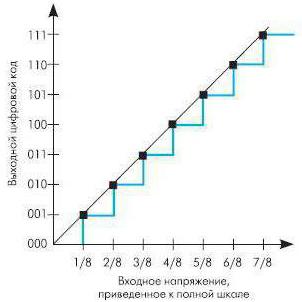General principle of the ADC
Let's look at the main range of issues,which can be attributed to the principle of the action of analog-to-digital converters (ADCs) of different types. A sequential account, bitwise balancing - what is hidden behind these words? What is the principle of operation of the microcontroller ADC? These, as well as a number of other issues, we will consider in the framework of the article. The first three parts will be devoted to the general theory, and from the fourth subheading we will study the principle of their work. You can meet the terms of ADC and DAC in different literature. The principle of operation of these devices is slightly different, so do not confuse them. So, the article will consider the conversion of signals from the analog form to the digital one, while the DAC works the other way around.
Definition
Before considering the principle of the ADC,let's find out what kind of device it is. Analog-to-digital converters are devices that convert a physical value into a corresponding numerical representation. As an initial parameter, almost anything can act: current, voltage, capacitance, resistance, shaft rotation angle, pulse frequency, and so on. But in order to have certainty, we will only work with one transformation. This is the "voltage-code". The choice of this format is not accidental. After all, the ADC (the principle of operation of this device) and its features depend to a large extent on what measurement concept is used. By this is meant the process of comparing a certain value with a previously established standard.

Characteristics of the ADC
The main ones are the bit-rate and the frequencytransformation. The first is expressed in bits, and the second is expressed in counts per second. Modern analog-to-digital converters can have a 24-bit capacity or conversion speed, which reaches GSPS units. Note that the ADC can simultaneously provide you with only one of its characteristics. The greater their performance, the more difficult it is to work with the device, and it itself is more expensive. But the benefit can be obtained the necessary digits, sacrificing the speed of the device.
Types of ADCs
The principle of operation differs among different groups of devices. We will consider the following types:
- With direct transformation.
- With successive approximation.
- With parallel transformation.
- Analog-digital converter with charge balancing (delta-sigma).
- Integrating ADCs.
There are many other conveyor and combinedtypes that have their own special characteristics with different architectures. But those samples that will be considered within the framework of the article are of interest because they play an indicative role in their niche of devices of this specificity. Therefore, let's study the principle of the ADC, as well as its dependence on the physical device.
Direct analog-to-digital converters
They became very popular in the 60-70sthe last century. In the form of integrated circuits are produced since the 80's. These are very simple, even primitive devices that can not boast of significant indicators. Their bit depth is usually 6-8 bits, and the speed rarely exceeds 1 GSPS.
The principle of operation of ADCs of this type is as follows: The plus inputs of the comparators simultaneously receive an input signal. The negative terminals are supplied with a voltage of a certain value. And then the device determines its operating mode. This is done due to the reference voltage. Let's say that we have a device with 8 comparators. When the ½ reference voltage is applied, only 4 of them will be enabled. Priority encoder will form a binary code, which is fixed by the output register. Concerning merits and demerits, it can be said that this principle of operation allows the creation of high-speed devices. But to get the required bit capacity you have to sweat a lot.

The general formula for the number of comparators isthus: 2 ^ N. Under N, you need to set the number of digits. The example considered earlier can be used again: 2 ^ 3 = 8. A total of 8 comparators are needed to obtain the third digit. This is the principle of the ADC, which were created first. Not very convenient, so in the subsequent there were other architectures.
Analog to Digital Converters
Here we use the "weighting" algorithm. In short, devices using this technique are called simply ADCs for sequential counting. The principle of operation is as follows: the device measures the value of the input signal, and then it is compared with the numbers that are generated according to a certain technique:
- Half of the possible reference voltage is set.
- If the signal has overcome the limit of the value from item# 1, then it is compared with the number that lies in the middle between the remaining value. So, in our case it will be ¾ of the reference voltage. If the reference signal does not reach this index, then the comparison will be performed with another part of the interval in the same way. In this example, it is ¼ of the reference voltage.
- Step 2 must be repeated N times, which will give us a N bit result. This is due to the H number of comparisons.
This principle of work allows you to receivedevices with a relatively high conversion speed, which are the ADCs of successive approximation. The principle of operation, as you can see, is simple, and these devices are excellent for different cases.

Parallel analog-to-digital converters
They work like serial devices. The formula for calculating is (2 ^ H) -1. For the case considered earlier, we need (2 ^ 3) -1 comparators. A certain array of these devices is used to operate, each of which can compare the input and individual reference voltages. Parallel analog-to-digital converters are quite fast devices. But the principle of building these devices is such that to support their performance requires considerable power. Therefore, it is not advisable to use them with battery power.
Analog-digital converter with bitwise balancing
It operates according to a similar scheme as the previous onedevice. Therefore, in order to explain the operation of the ADC of bitwise balancing, the principle of work for beginners will be considered literally on the fingers. At the heart of these devices is the phenomenon of dichotomy. In other words, a consistent comparison of the measured quantity with a certain part of the maximum value is carried out. Values in ½, 1/8, 1/16 and so on can be taken. Therefore, the analog-to-digital converter can perform the entire process for H iterations (consecutive steps). And H is equal to the ADC bit width (look at the previously given formulas). Thus, we have a significant gain in time, if the speed of the technique is particularly important. Despite the considerable speed, these devices are also characterized by a low static error.

Analog-digital converters with charge balancing (delta-sigma)
This is the most interesting type of device, not inthe last because of its principle of work. It consists in the fact that the input voltage is compared with what was accumulated by the integrator. Pulses with negative or positive polarity are fed to the input (all depends on the result of the previous operation). Thus, it can be said that such an analog-to-digital converter is a simple tracking system. But this is only as an example for comparison, so you can understand what a delta-sigma ADC is. The principle of operation is system, but for the effective operation of this analog-to-digital converter is not enough. The end result is an endless stream of units and zeros that goes through a digital LPF. Of these, a certain bit sequence is formed. A distinction is made between ADC converters of the first and second orders.
Integrated analog-to-digital converters
This is the last special case that will beconsidered within the framework of the article. Next, we will describe the principle of operation of these devices, but at a general level. This ADC is an analog-to-digital converter with push-pull integration. You can meet a similar device in a digital multimeter. And this is not surprising, because they provide high accuracy and simultaneously well suppress interference.
Now let's focus on its principlework. It consists in that the input signal charges the capacitor for a fixed time. Typically, this period is the unit of the network frequency that powers the device (50 Hz or 60 Hz). It can also be a multiple. Thus, high-frequency noise is suppressed. At the same time, the influence of the unstable voltage of the grid source of electric power generation on the accuracy of the result is leveled.

When the charging time of the analog-digitalconverter, the capacitor begins to discharge at a certain fixed speed. The internal counter of the device counts the number of clock pulses that are generated during this process. Thus, the longer the time interval, the more significant the indicators.
ADCs of push-pull integration have a highaccuracy and resolution. Thanks to this, and also a relatively simple structure of construction, they are performed as chips. The main drawback of this principle of work is the dependence on the indicator of the network. Remember that its capabilities are tied to the duration of the power supply frequency period.
Here's how the double-integration ADC works. The principle of operation of this device, although it is quite complex, but it provides quality indicators. In some cases, this is simply necessary.
Choose an AIC with the principle of work we need
Suppose we face a certain task. How to choose a device so that it can satisfy all our requests? First, let's talk about resolution and accuracy. Very often they are confused, although in practice they are very weakly dependent on one from the second. Remember that a 12-bit analog-to-digital converter can have less accuracy than an 8-bit one. In this case, the resolution is a measure of how many segments can be extracted from the input range of the measured signal. So, 8-bit ADCs have 28= 256 such units.
Accuracy is the total deviation of the obtainedthe result of the conversion from the ideal value, which should be at a given input voltage. That is, the first parameter characterizes the potential capabilities of the ADC, and the second shows what we have in practice. Therefore, we can approach a simpler type (for example, direct analog-to-digital converters), which will satisfy the needs due to high accuracy.

To have an idea of what is needed, forit is necessary to calculate physical parameters and construct a mathematical formula for interaction. Important in them are static and dynamic errors, because when using different components and principles of constructing a device, they will have different effects on its characteristics. More detailed information can be found in the technical documentation that the manufacturer of each particular device offers.
Example
Let's look at the ADC SC9711. The principle of operation of this device is complicated due to its size and capabilities. By the way, speaking about the latter, it must be noted that they are really diverse. So, for example, the frequency of possible work ranges from 10 Hz to 10 MHz. In other words, it can do 10 million counts per second! And the device itself is not something integral, but has a modular structure of construction. But it is used, as a rule, in a complex technique, where it is necessary to work with a large number of signals.

Conclusion
As you can see, ADCs basically have differentwork principles. This allows us to select devices that satisfy the requests that arise, and at the same time allow us to use the available means wisely.





